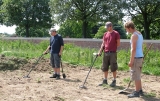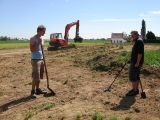In search of traces of the field hospital
The site where the archaeology is taking place is a historically important place. During the whole of the Great War, a field hospital was situated on this piece of land. The French hospital came first, in early spring, 1915. The Canadian Casualty Clearing station took over in August 1916. They enlarged the field hospital and constructed an operation ward, separate barracks for light and serious surgical cases, wards for sick patients and an officers' ward. There was a large admitting room. The sister and the officer in charge had huts of their own.
The archaeological research is done with metal detectors. After the surface level has been examined, the archaeologists start digging, up to fifteen centimetres below the ground level. In a third phase the ground is removed up to a depth of forty centimetre. All artefacts are photographed and indicated on a map. The archaeological campaign will last for six weeks. At the end of the first day, a good number of buttons and coins had been noted. The researchers also found a dog tag with the reference C. Folley. The soldier however is not buried in Lijssenthoek.














